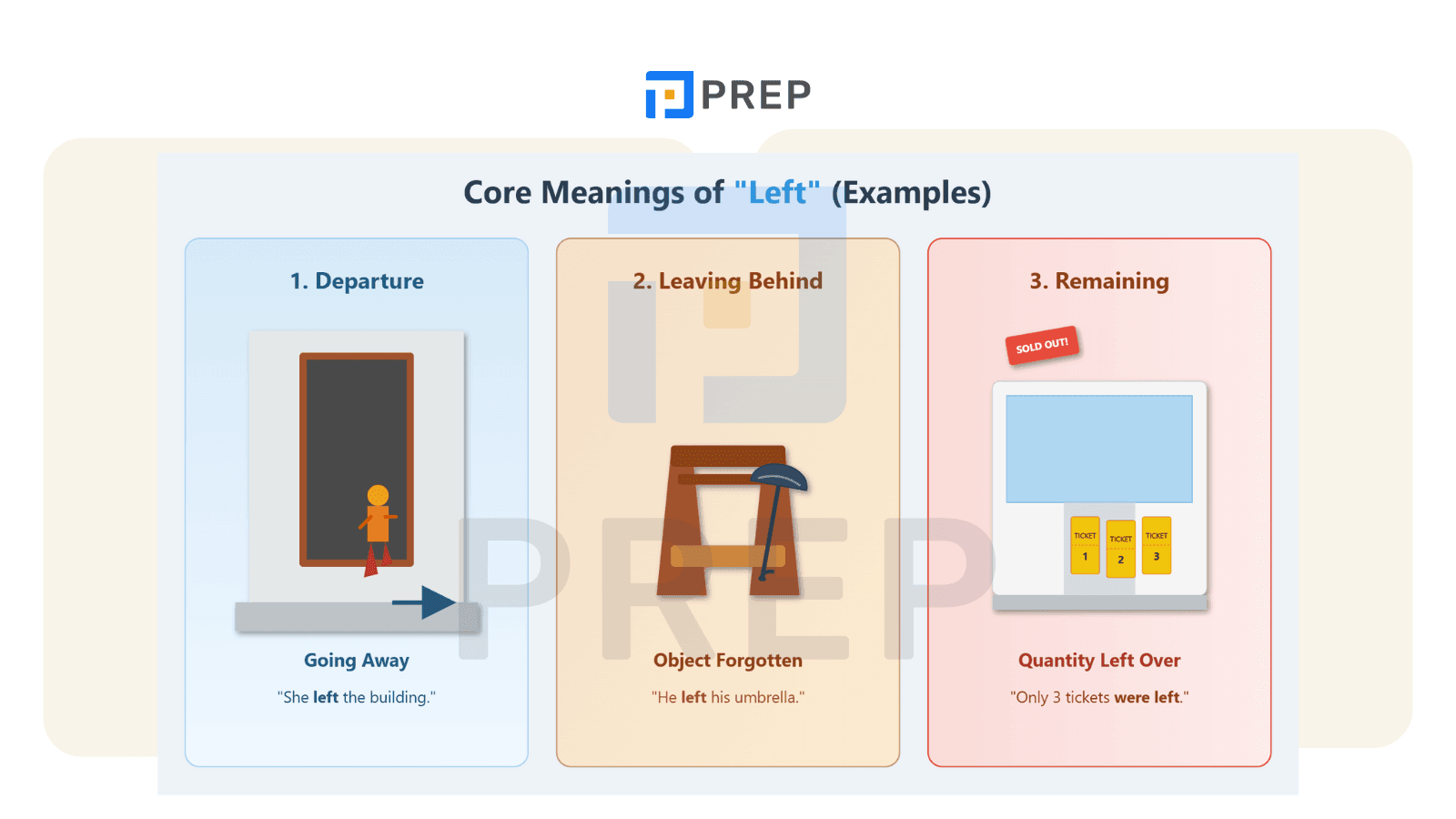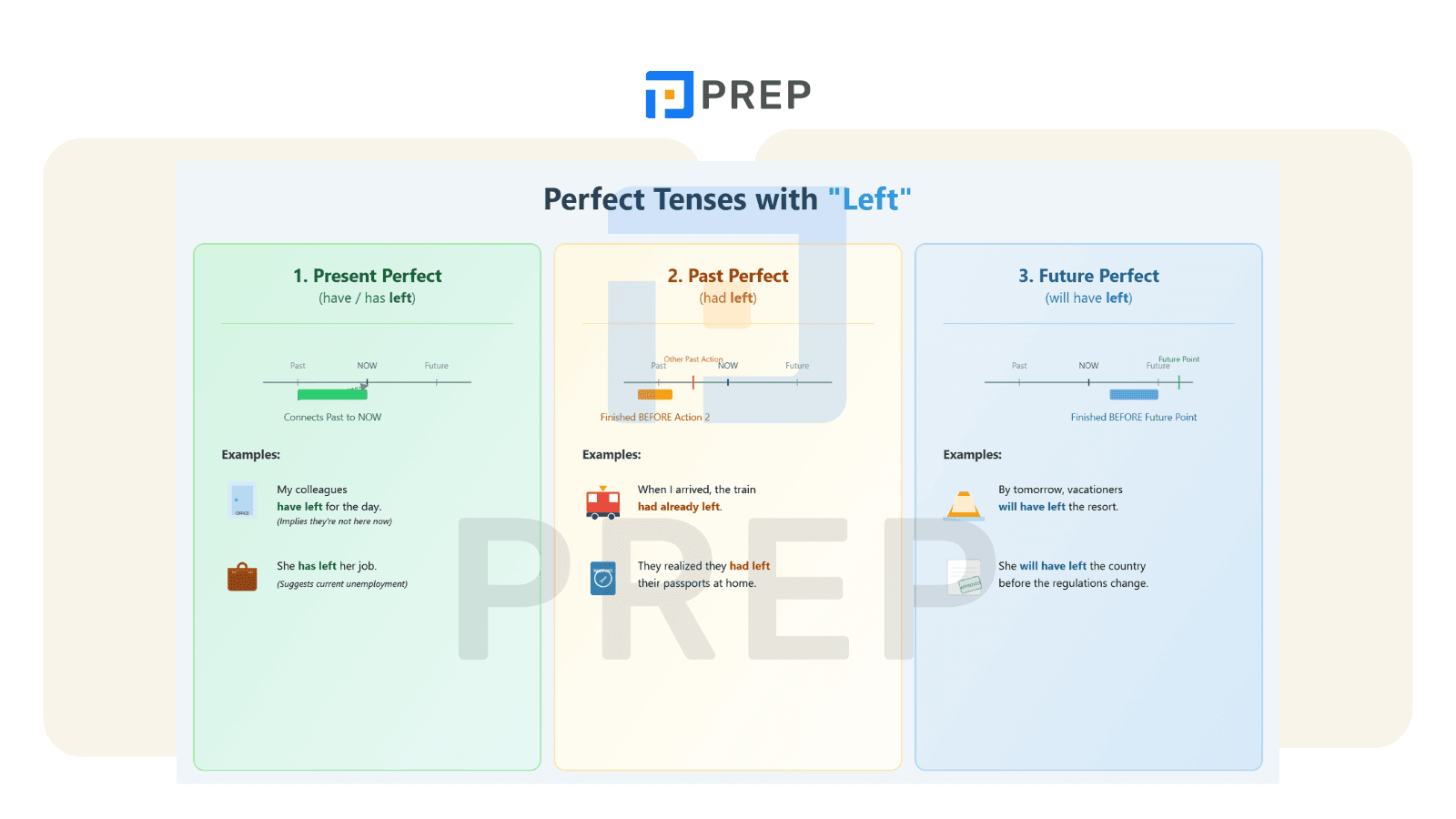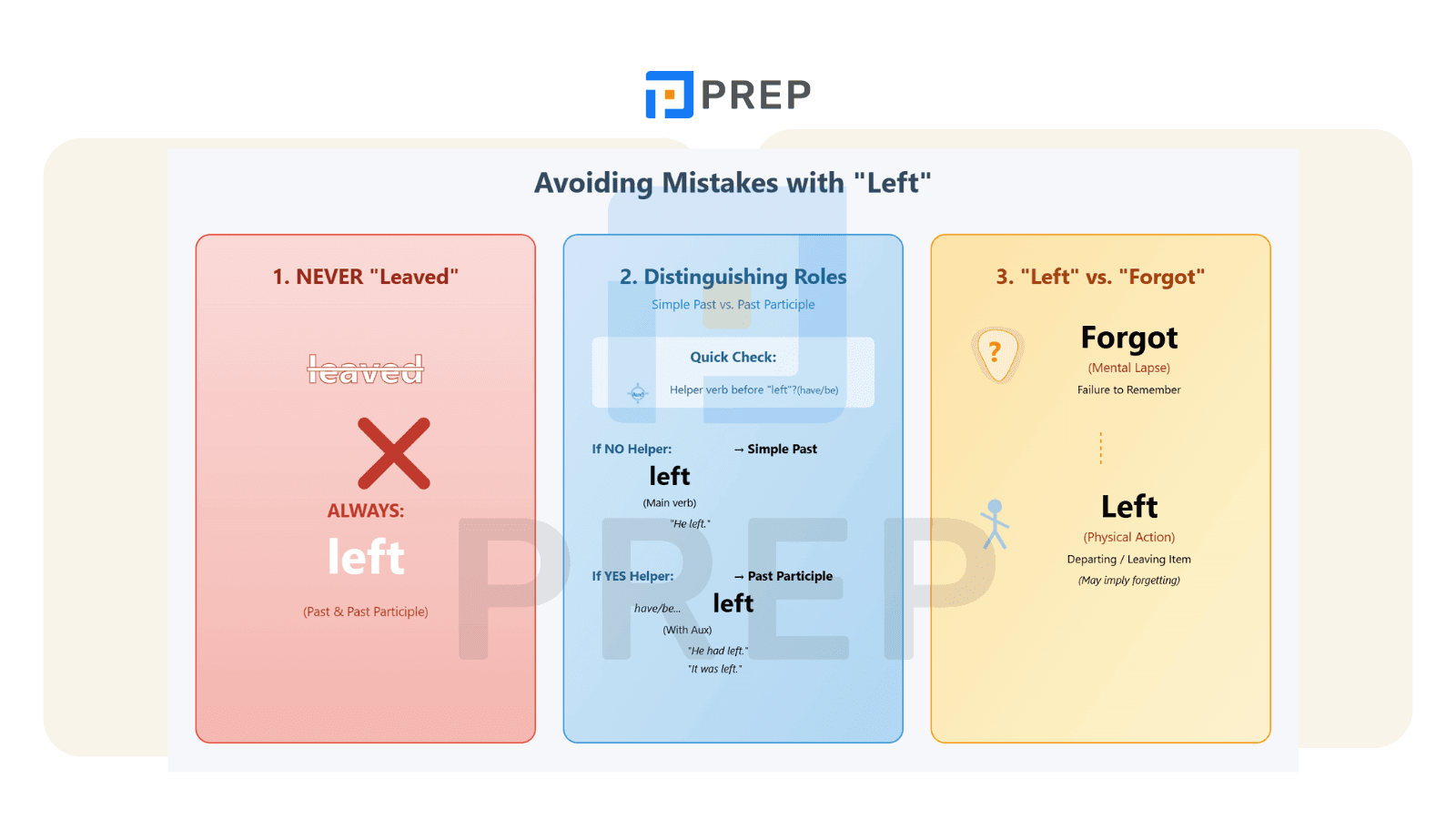Your Definitive Guide to Using Past Tense of Leave Correctly
This comprehensive guide provides a detailed examination of "left" as the past tense of Leave, covering its grammatical structure, usage patterns, and semantic variations. The content systematically explains why "leave" transforms to "left" rather than following regular "-ed" conjugation, outlines the principal parts of the verb, and distinguishes between past simple and past participle applications. The article explores three core meanings of "left" (departing, abandoning, and allowing to remain), demonstrates correct sentence construction across affirmative, negative, and interrogative forms, and examines common phrasal verbs incorporating "left."

I. "Left" is the Past Tense of Leave
The past tense of the verb "leave" is "left." This straightforward answer forms the foundation for understanding how to use this common yet frequently misunderstood verb correctly. Throughout this guide, we will explore the grammatical nuances and practical applications of "left" to help you master this essential verb form.
"Leave" belongs to a category of English verbs known as irregular verbs. Unlike regular verbs that form their past tense by adding "-ed" to the base form, irregular verbs change their spelling entirely when shifted to past tense. This explains why the correct past tense form is "left" rather than "leaved." This transformation follows no predictable pattern, making it necessary to memorize this specific change.
II. Mastering "Left" in the Simple Past Tense: Completed Actions
1. Core Meaning 1: Departure or Going Away
The most common meaning of "left" relates to departing from a location. This usage typically follows the structure: Subject + left + Place/Time/Destination. Leave in past simple follows this straightforward pattern.
For example:
-
She left the building after the meeting ended.
-
We left for Singapore yesterday on the evening flight.
This core meaning communicates physical movement away from a specific location, with the action completed entirely in the past. The past tense of leave clearly indicates the action is finished.
2. Core Meaning 2: Leaving Something or Someone Behind
"Left" also describes the action of deliberately or accidentally abandoning objects or people in a location. This usage follows the structure: Subject + left + Object + Location.
For instance:
-
He left his umbrella at the restaurant last night.
-
They left their children with grandparents during their anniversary trip.
This meaning often carries implications of forgetfulness or intentional placement, depending on context. The past form of leave clarifies that this action occurred completely in the past.
3. Core Meaning 3: A Remaining Quantity (Often Passive Implication)
"Left" can refer to something that remains after an action or process. This meaning frequently appears in constructions like "was left" or "is left," suggesting a quantity or item that remains.
Consider these examples:
-
Only three tickets were left for the sold-out concert.
-
She had very little energy left after the marathon.
This usage focuses attention on what remains rather than the action of leaving itself. The past tense of leave in this context relates to remaining quantities.

4. Forming negatives and questions with Past simple irregular verbs Leave
Creating negative statements and questions with the past tense of leave requires the auxiliary verb "did." This pattern differs from forming the simple statement with "left."
4.1 The Negative: Using "did not leave" (didn't leave)
To form a negative statement in the past tense, use the structure: Subject + didn't + leave + complement.
Critical point: After "didn't," revert to the base form "leave"—not "left." For example:
-
He didn't leave the party early. (NOT "He didn't left the party early.")
-
They didn't leave any food for us. (NOT "They didn't left any food for us.")
This pattern applies to all verbs in English when forming negatives with "did not," including when using the past tense of leave.
4.2 The Question: Using "Did [subject] leave...?"
Questions in the simple past follow this structure: Did + Subject + leave + complement?
Again, use the base form "leave" after "did"—never "left." For example:
-
Did you leave your keys in the car? (NOT "Did you left your keys in the car?")
-
Did she leave without saying goodbye? (NOT "Did she left without saying goodbye?")
This consistent pattern helps maintain grammatical accuracy in all interrogative past tense forms when working with the past tense of leave.
III. "Left" as Past Simple vs. "Left" as Past Participle
Past simple "left" indicates actions that started and finished at a specific point in the past. This form often appears with past time markers like "yesterday," "last week," or "ago":
-
Sarah left for her vacation last Tuesday, planning to return after the Mid-Autumn Festival. (Specific past time marker)
-
We left a detailed note for them before we went out, explaining where to find emergency contact information. (Completed prior action)
IV. Mastering "Left" as a Past Participle
While "left" serves as both the simple past and past participle of "leave," its grammatical function changes depending on surrounding words. Let's examine how "left" operates within perfect tenses and passive voice constructions. Understanding leave past tense and past participle uses will improve your English fluency.
1. Usage in Perfect Tenses (Action related to another time point)
Perfect tenses use "left" as a past participle combined with auxiliary verbs (have, has, had) to establish relationships between different time points. This creates more complex temporal meanings than the simple past alone.
1.1 Present Perfect: "have left" / "has left"
The present perfect tense connects a past action to the present moment, often without specifying exactly when the action occurred. It emphasizes current relevance or continuing effects. Leave in past perfect tenses like this creates important temporal connections.
For example:
-
My colleagues have left for the day. (Implies they're not here now)
-
She has left her job. (Suggests a current state of unemployment)
The present perfect using "have/has left" indicates completion with present relevance, unlike the simple past "left," which merely reports a finished action when using the past tense of leave.
1.2 Past Perfect: "had left"
Past perfect establishes that one action occurred before another past action. It uses the structure: Subject + had + left + complement.
For example:
-
When I arrived at the station, the train had already left.
-
They realized they had left their passports at home only after reaching the airport.
This tense creates clear sequencing between two past events, showing which happened first. The past tense of leave in this context helps establish chronology.
1.3 Future Perfect: "will have left"
Future perfect projects completion of an action before a specific future time point. It follows the structure: Subject + will have + left + complement.
For example:
-
By this time tomorrow, most vacationers will have left the resort.
-
She will have left the country before the new regulations take effect.
Though less common than other perfect forms, this tense precisely communicates expected completion before a future reference point using the past participle of leave.

2. Usage in the Passive Voice (Subject receives the action)
When the receiver of the action becomes the grammatical subject, "left" serves as a past participle in passive voice constructions with forms of "to be." The past tense of leave works differently in passive structures.
2.1 Structure: Form of "to be" + left
This straightforward pattern creates various passive meanings depending on the tense of "to be."
2.2 Example 1 (Simple Past Passive): The package was left by the door.
Here, the package receives the action of being left—it's the grammatical subject though not the performer of the action.
2.3 Example 2 (Present Perfect Passive): No instructions have been left.
This construction combines perfect tense and passive voice, showing completion with current relevance while focusing on the receiving entity. The past tense of leave combines with auxiliary verbs to create complex meanings.
2.4 Example 3 (Common Phrase): He was left speechless.
Many idiomatic expressions use the passive form of "left" to describe emotional or situational outcomes, emphasizing the effect rather than the cause.
V. Avoiding Common Mistakes: "Left" vs. Similar Concepts
1. Never Use "Leaved"
Remember: "leaved" is always incorrect as the past tense or past participle of "leave." The only acceptable form is "left" in both functions. This is a fundamental rule when mastering the past tense of leave.
2. Distinguishing Simple Past "Left" from Past Participle "Left"
Though identical in form, the simple past "left" stands alone as the main verb in a sentence, while the past participle "left" always works with auxiliary verbs in perfect tenses or passive voice constructions. This distinction is crucial when using the past tense of leave correctly.
If "left" appears after any form of "have" or "be," it's functioning as a past participle; otherwise, it's the simple past tense.
3. "Left" vs. "Forgot"
These related concepts have subtle but important differences. "Forgot" primarily describes a mental failure to remember, while "left" focuses on the physical action of departing or leaving something behind, which may imply forgetting.
For example, "I forgot my homework" emphasizes memory failure, while "I left my homework at home" focuses on the physical act of leaving the item behind. In casual conversation, these distinctions often blur, but precision matters in formal writing and language exams like IELTS. Understanding the past tense of leave helps express these nuances accurately.
Now that we've covered the main uses and common pitfalls of "left," let's address some specific questions that frequently arise about this versatile verb form.

VI. Further Questions Answered About "Left"
1. Is "left" the only past form of "leave"?
Yes, "left" serves as both the simple past tense and past participle form of "leave" in all standard contexts. The past tense of leave remains consistent.
2. What are the "principal parts" of the verb "leave"?
The principal parts are: leave (base form), leaves (third-person singular present), leaving (present participle), left (simple past), and left (past participle). Understanding these forms helps master the past tense of leave.
3. What are the main categories of meaning when using the simple past "left"?
The three main meanings are: departure (going away from a place), leaving behind (objects or people), and indicating a remaining quantity. Each meaning uses the past tense of leave slightly differently.
4. How does the function of "left" in "He left" differ from "He has left"?
"He left" (simple past) indicates a completed action at a specific past time, while "He has left" (present perfect) suggests an action with current relevance or continuing effects. This demonstrates how the past tense of leave operates in different contexts.
5. Can "left" be used as an adjective?
Yes, "left" functions as an adjective when describing direction (opposite of right) or remaining quantities ("two cookies left"), distinct from its verb form. This is separate from the past tense of leave usage.
By thoroughly understanding the past tense of leave and its various applications, you establish a strong foundation for expressing past actions clearly and precisely in English. This knowledge contributes significantly to overall language proficiency and communication effectiveness in both academic and real-world settings.

Hi I'm Chloe, and I am currently serving as an Product Content Administrator at Prep Education. With over five years of experience in independent online IELTS study and exam preparation, I am confident in my ability to support learners in achieving their highest possible scores.
Comment
Premium content
View allPersonalized roadmap
Most read












